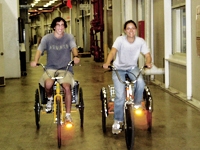Students tackle unusual research at Argonne National Laboratory

MIDDLEBURY, Vt. ? Two environmental chemistry majors, an enthusiastic professor, and the fast-moving, high-powered x-ray beams of the Advanced Photon Source (APS) at Argonne National Laboratory in Argonne, Ill., make for some pretty dynamic research. Add the fact that the data must be collected in only 24 hours, and it becomes a combination of science and extreme sports.
Ross Lieb-Lappen and Katie Harrold, both seniors at Middlebury College, spent a rigorous day at the Argonne lab last summer with their mentor and guide Molly Costanza-Robinson, assistant professor of environmental chemistry at Middlebury. Their goal was to use Argonne’s x-ray beam in an innovative, three-dimensional imaging technique that analyzes air and water flow through soil to better understand the environmental impact of certain contaminants.
Argonne National Laboratory occupies 1,500 wooded acres about 25 miles outside Chicago and is operated by the University of Chicago for the United States Department of Energy’s Office of Science. Researchers from around the world use Argonne’s APS facilities to expose their experiments to the most brilliant x-ray beams in the Western Hemisphere. The APS has a single beam line for the analysis of environmental soil samples, and for a few months each year, the lab offers 24-hour sessions for 3-D imaging research. Costanza-Robinson wrote a proposal for her students’ research, and they were offered a 24-hour session beginning at 8 a.m. July 26.
“The APS works by accelerating electrons close to the speed of light and then sending them around a one-kilometer circumference storage ring, causing them to give off electromagnetic radiation,” explained Lieb-Lappen. “This is what we used to take high-level x-rays. From these images, we ‘taught’ a computer how to measure the area between the air and the water in our soil columns.”
Costanza-Robinson and her students made full use of their 24 hours at Argonne. “The key was to stay up the entire time we were ‘on line,’” she said. For the two students, that meant lots of coffee and conversation. With a circumference of 1,104-meters, the APS is large enough to hold a baseball park in its center, and so to fetch the coffee and snacks, they took turns riding the lab’s specialized trikes to and from the indoor restaurant and vending machines.
“The trikes are a great way to get around,” said Harrold. “But they take a little while to get used to.” Not having ridden one for about 20 years, she quickly remembered to use her front tire - not her weight - to steer.
The temperature in the APS facility is maintained at a constant 72°F year round, and cell phone usage inside is minimal. “It’s bunker-like in there,” said Costanza-Robinson. “But the place is hopping. Even in the middle of the night, there are scientists on every beam line and everyone is incredibly focused on this intense opportunity to gather data.”
Back at school this fall, Costanza-Robinson and her students are taking a close look at the multitude of data collected at Argonne. They plan to share their results in December. In this time of intense environmental scrutiny nationwide, the results of their work could have a marked impact on future understanding of soil contaminants.

